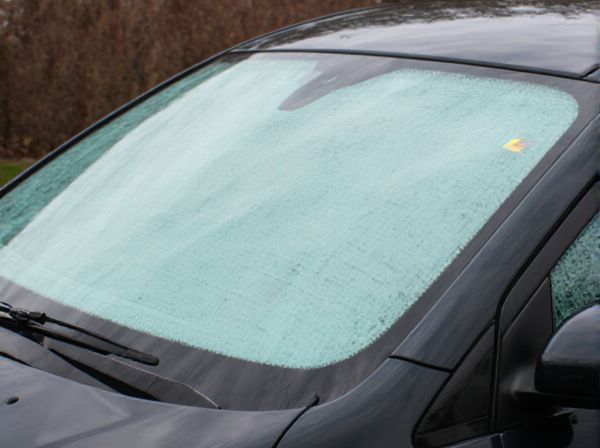
Photo illustration: Acoustic Windshield vs Standard Windshield
An acoustic windshield is designed with laminated glass that reduces outside noise, providing a quieter driving experience compared to a standard windshield. Its soundproofing properties help minimize wind, traffic, and environmental sounds, enhancing comfort during your rides. Investing in an acoustic windshield can significantly improve cabin tranquility without compromising safety or visibility.
Table of Comparison
| Feature | Acoustic Windshield | Standard Windshield |
|---|---|---|
| Noise Reduction | High - reduces external noise by up to 30% | Low - minimal noise insulation |
| Material | Laminated glass with acoustic interlayer | Tempered or laminated glass without acoustic layer |
| Thickness | Thicker due to sound-absorbing layer (typically 6.76mm) | Standard thickness (typically 4-5mm) |
| Cost | 20-30% higher than standard windshield | Lower cost, widely available |
| Durability | High resistance to cracks and chips | Moderate durability |
| UV Protection | Included with acoustic layer | Basic UV protection |
| Ideal Use | Luxury and premium cars, noise-sensitive environments | Economy and standard vehicles |
Understanding Acoustic and Standard Windshields
Acoustic windshields utilize laminated glass with a specialized acoustic interlayer designed to reduce external noise, enhancing cabin quietness significantly compared to standard windshields. Standard windshields are typically made of laminated glass without noise-reducing layers, prioritizing basic safety and structural integrity. The unique construction of acoustic windshields helps diminish vibrations and block sound waves, providing a more comfortable driving experience in noisy environments.
Key Differences Between Acoustic and Standard Windshields
Acoustic windshields feature a specialized laminated glass with an inner acoustic interlayer designed to reduce external noise, whereas standard windshields typically consist of two layers of glass with a basic plastic interlayer offering minimal sound insulation. The key differences lie in noise reduction performance, with acoustic windshields providing enhanced cabin quietness by dampening high-frequency sounds like wind and engine noise. Additionally, acoustic windshields often improve overall driving comfort and concentration, making them preferred for luxury vehicles or long-distance travel.
How Acoustic Windshields Reduce Noise
Acoustic windshields use laminated glass with a special sound-dampening interlayer that absorbs and blocks external noise more effectively than standard windshields. This design minimizes vibrations and reduces the transmission of wind and road sounds inside the vehicle cabin. The enhanced noise reduction improves driving comfort and creates a quieter interior environment.
Material Composition: Acoustic vs Standard Glass
Acoustic windshields feature a laminated glass composition with a specialized acoustic interlayer designed to reduce noise transmission, enhancing cabin quietness compared to standard windshields. Standard windshields typically use a conventional laminated glass structure that prioritizes safety and impact resistance without sound-dampening elements. The unique acoustic interlayer in acoustic windshields significantly absorbs and blocks external sounds, making it a superior choice for noise reduction in vehicles.
Benefits of Acoustic Windshields
Acoustic windshields utilize a specialized inner layer of sound-absorbing material that significantly reduces road noise and vibrations, enhancing cabin quietness compared to standard windshields. This improved sound insulation not only provides a more comfortable driving experience but also allows for better audio system clarity and reduced driver fatigue on long journeys. Enhanced acoustic performance contributes to higher vehicle resale value by appealing to customers seeking superior comfort and noise reduction technologies.
Cost Comparison: Acoustic vs Standard Windshields
Acoustic windshields typically cost 20-30% more than standard windshields due to advanced laminated glass layers designed to reduce noise. Standard windshields use basic laminated glass, making them more affordable but less effective in sound insulation. Choosing an acoustic windshield may increase upfront expenses but offers long-term comfort benefits in noise reduction.
Installation Process Differences
Acoustic windshields require more precise installation techniques due to their multiple laminated layers designed to reduce noise, often necessitating specialized adhesives and careful alignment to maintain acoustic performance. Standard windshields typically involve a more straightforward installation using conventional adhesives and standard fitting procedures. Proper installation of acoustic windshields minimizes sound leakage and vibration, which is crucial for maximizing their noise-reduction benefits compared to standard windshields.
Durability and Safety Features
Acoustic windshields utilize laminated glass with an acoustic interlayer, enhancing noise reduction while providing superior impact resistance compared to standard windshields made from conventional laminated glass. The multi-layer design in acoustic windshields increases durability by better absorbing shocks and preventing shattering, which improves overall safety during collisions. These advanced safety features also contribute to maintaining structural integrity of the vehicle, reducing the risk of glass fragments injuring occupants.
Acoustic Windshield Maintenance Tips
Acoustic windshields contain a special laminated layer designed to reduce noise and vibrations compared to standard windshields, enhancing cabin comfort. To maintain acoustic windshields, avoid harsh chemicals and abrasive materials during cleaning, opting for mild soap and water instead to preserve the sound-dampening layer. Regular inspections for chips or cracks ensure the acoustic properties remain effective, and professional repairs are recommended to prevent further damage.
Which Windshield Is Right for Your Vehicle?
Acoustic windshields feature an inner layer of sound-absorbing material that significantly reduces road and wind noise compared to standard windshields, making them ideal for drivers seeking a quieter cabin environment. Standard windshields, typically made from laminated safety glass without noise-dampening layers, offer durability and cost-effectiveness for everyday use. Choosing the right windshield depends on your priorities for noise reduction, budget, and vehicle type, with acoustic windshields favored in luxury or long-distance vehicles and standard windshields suited for basic replacement needs.
 caratoz.com
caratoz.com